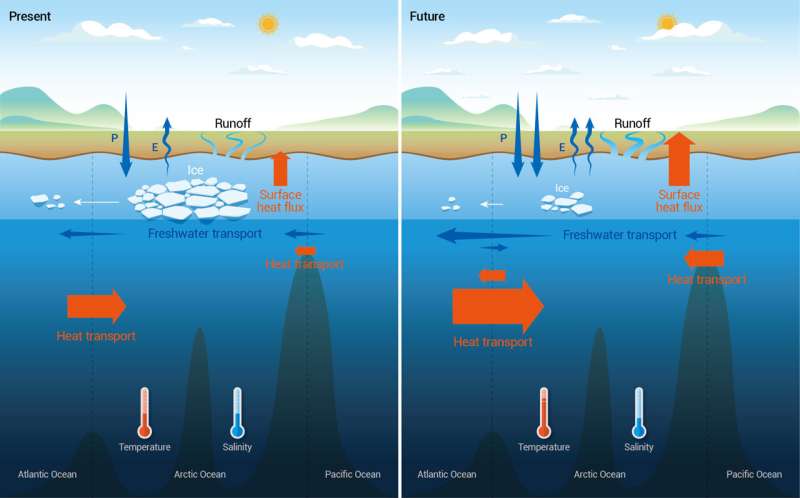This article has been reviewed according to Science X's editorial process and policies. Editors have highlighted the following attributes while ensuring the content's credibility:
fact-checked
proofread
Climate change is altering the linkage between the Arctic and subarctic oceans, finds study

The Arctic Ocean is connected with the Pacific and the Atlantic Oceans through several ocean gateways, and changes in the linkage between these oceans and the Arctic Ocean can affect both climate and marine ecosystems.
Notable changes have been observed in the inflows and outflows of the Arctic Ocean over the past decade, including unprecedented high temperatures and remarkably low salinities. Models suggest additional ocean heat transfer to the Arctic Ocean in the future due to warming inflow waters, which will lead to amplified warming in the Arctic Ocean.
They also predict increasing exports of low-salinity waters from the Arctic Ocean to the North Atlantic Ocean as the climate continues to warm. The warming of the Arctic Ocean and the increase in freshwater exports to the North Atlantic Ocean could have significant impacts on marine life and the evolution of the climate.
A team of leading oceanographers recently reviewed current research analyzing the waters that flow between the Arctic and subarctic oceans and studies aimed at predicting the temperature, salinity and volume transport of water at these connection points in the future. Acquiring a comprehensive understanding and making accurate predictions of these changes is essential for effective policy-making and the development of mitigation strategies in the context of climate change.
The researchers published their review in the journal Ocean-Land-Atmosphere Research.
"We conducted a review of prior observational and modeling studies on Arctic-subarctic ocean linkages and examined their changes and driving mechanisms," said Qiang Wang, first author of the review paper and senior scientist at the Alfred Wegener Institute Helmholtz Centre for Polar and Marine Research (AWI) in Bremerhaven, Germany.
Overall, studies observed stronger heat convergence, or increased heat transport, to the Arctic Ocean in the 2010s. These changes have been attributed to the warming inflow waters from subarctic oceans. Additionally, there is evidence of an increase in the volume of ocean inflows, responsible for carrying warm waters from the Pacific and Atlantic into the Arctic Ocean.
Simultaneously, the Arctic Ocean experienced reduced sea ice formation and increased freshwater input from river runoff and precipitation. Furthermore, the inflow of low-salinity water from the Pacific Ocean further contributed to the decrease in Arctic salinity. These changes are indicative of ongoing climate change.
"Both the ocean heat convergence from lower latitudes to the Arctic Ocean and the hydrological cycle connecting the Arctic with subarctic seas were stronger in 2000-2020 than in 1980-2000 and will continue to be intensified in a future warming climate," said Wang.
CMIP6, or Coupled Model Intercomparison Project phase 6, climate modeling predictions suggest that the warming rate of the Arctic Ocean is about twice the global average and will remain at this level due to increasing ocean heat convergence into the Arctic Ocean.
The Barents Sea Opening, between Bear Island in the south of Svalbard and the northernmost point of Norway, is predicted to be the largest heat source of the Arctic Ocean. The increase in this heat source contributes to the retreat of Arctic sea ice in cold seasons and fuels the warming of the atmosphere.
The Arctic Ocean will experience an increase in freshwater input through increased net precipitation, river runoff and overall sea ice decline. Importantly, freshwater export from the Arctic to the Atlantic Ocean plays a major role for the Atlantic Meridional Overturning Circulation, or AMOC. Modeling predicts that freshwater exports from the Arctic to the North Atlantic Ocean via Fram Strait, located between Greenland and Svalbard, will increase due to enhanced freshwater input to the Arctic Ocean, affecting large-scale ocean circulations and climate.
"Both observation and modeling capabilities need to be further improved to better monitor and predict changes in Arctic-subarctic ocean linkages," said Wang. There is a need to better understand forcing, or the effects of winds, tides, heating, cooling, precipitation, evaporation and river discharge on ocean circulation and water property both inside and outside the Arctic.
Realistically representing these effects in models is crucial. The researchers also argued that currently available observational instruments are insufficient for accurately measuring ocean transports in all the Arctic gateways.
To enhance our understanding of the ocean and climate change, it is crucial to collectively examine the intricate processes involved in Arctic-subarctic exchanges. For example, freshwater outflow from the Fram Strait can affect the air-sea heat exchange in the Greenland Sea and influence ocean heat flux.
Furthermore, enhanced freshwater flux through the Davis Strait could reduce the freshwater export in the Fram Strait, so the exports in both straits are subject to sea level changes in the subpolar North Atlantic. Modeling should adequately account for all these comprehensive processes to enhance ocean and climate predictions.
More information: Qiang Wang et al, A review of Arctic-Subarctic ocean linkages: past changes, mechanisms and future projections, Ocean-Land-Atmosphere Research (2023). DOI: 10.34133/olar.0013
Provided by Ocean-Land-Atmosphere Research (OLAR)





















